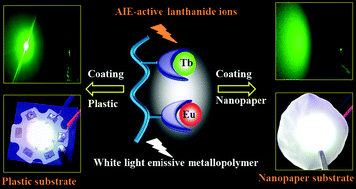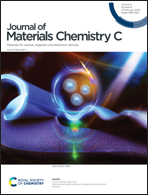Aggregation-induced white emission of lanthanide metallopolymer and its coating on cellulose nanopaper for white-light softening†
Abstract
A series of metallopolymers containing two lanthanides (Poly-Eu-Tb, molar ratio of Eu3+/Tb3+ = 1 : 1, 1 : 2, 1 : 4 and 1 : 8) have been synthesized via the coordination of Eu3+ and Tb3+ ions to terpyridine-based polymers (Poly). At a high concentration (1 mg mL−1) in DMF, Poly-Eu-Tb with an optimal Eu3+/Tb3+ ratio (1 : 8) shows strong white light emission from the Poly backbone and Eu3+ and Tb3+ ions, but changes to very weak blue emission mainly from the Poly backbone when diluted to an extremely low concentration (0.1 mg mL−1). For typical aggregation-induced-emission (AIE) effects, a strong white light emission can be recovered along with the addition of 1,4-dioxane to the diluted DMF solution. Moreover, Poly-Eu-Tb is uniformly dispersed on the surface of cellulose nanopaper (CNFs) via a simple solution coating process, giving a new flexible cellulose nanopaper Poly-Eu-Tb-CNFs. The new cellulose nanopaper characteristic of UV-excited white light emission shows excellent haze properties (haze value as high as 98%) and therefore could be applied as a substrate and light diffuser in the fabrication of soft-white-light emitting diodes (SWLEDs).



 Please wait while we load your content...
Please wait while we load your content...